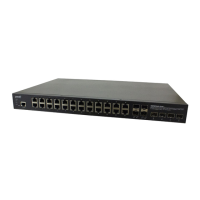Lantronix SISPM1040-xxxx-L3 Web User Guide
33856 Rev. A https://www.lantronix.com/ 37
System > LLDP > LLDP-MED Neighbor
This page provides a status overview of all LLDP-MED neighbors. The displayed table contains a row for each
interface on which an LLDP neighbor is detected. This function applies to VoIP devices which support LLDP-
MED.
Port: The interface on which the LLDP frame was received.
Device Type: LLDP-MED Devices are comprised of two primary Device Types: Network Connectivity Devices
and Endpoint Devices.
LLDP-MED Network Connectivity Device Definition: LLDP-MED Network Connectivity Devices, as defined in
TIA-1057, provide access to the IEEE 802 based LAN infrastructure for LLDP-MED Endpoint Devices. An LLDP-
MED Network Connectivity Device is a LAN access device based on any of these technologies:
1. LAN Switch/Router
2. IEEE 802.1 Bridge
3. IEEE 802.3 Repeater (included for historical reasons)
4. IEEE 802.11 Wireless Access Point
5. Any device that supports the IEEE 802.1AB and MED extensions defined by TIA-1057 and can relay
IEEE 802 frames via any method.
LLDP-MED Endpoint Device Definition: LLDP-MED Endpoint Devices, as defined in TIA-1057, are located at
the IEEE 802 LAN network edge, and participate in IP communication service using the LLDP-MED framework.
Within the LLDP-MED Endpoint Device category, the LLDP-MED scheme is broken into further Endpoint Device
Classes, as defined in the following.
Each LLDP-MED Endpoint Device Class is defined to build upon the capabilities defined for the previous Endpoint
Device Class. For-example will any LLDP-MED Endpoint Device claiming compliance as a Media Endpoint (Class
II) also support all aspects of TIA-1057 applicable to Generic Endpoints (Class I), and any LLDP-MED Endpoint
Device claiming compliance as a Communication Device (Class III) will also support all aspects of TIA-1057
applicable to both Media Endpoints (Class II) and Generic Endpoints (Class I).
LLDP-MED Generic Endpoint (Class I): The LLDP-MED Generic Endpoint (Class I) definition is applicable to all
endpoint products that require the base LLDP discovery services defined in TIA-1057, however do not support IP
media or act as an end-user communication appliance. Such devices may include (but are not limited to) IP
Communication Controllers, other communication related servers, or any device requiring basic services as
defined in TIA-1057.
Discovery services defined in this class include LAN configuration, device location, network policy, power
management, and inventory management.
LLDP-MED Media Endpoint (Class II): The LLDP-MED Media Endpoint (Class II) definition is applicable to all
endpoint products that have IP media capabilities however may or may not be associated with a particular end
user. Capabilities include all of the capabilities defined for the previous Generic Endpoint Class (Class I), and are

